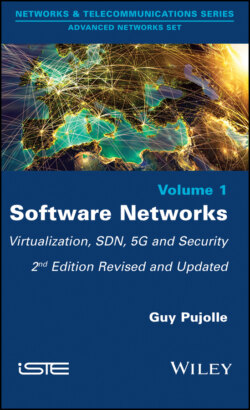Читать книгу Software Networks - Guy Pujolle - Страница 21
1.5. Virtual devices
ОглавлениеAll devices can be virtualized, with the exception of those which handle the reception of terrestrial and wireless signals, such as electromagnetic signals or atmospheric pressure. For example, an antenna or thermometer could not be replaced by a piece of software. However, the signal received by that antenna or thermometer can be processed by a virtual machine. A sensor picking up a signal can select an appropriate virtual processing machine in order to achieve a result that is appropriate for the demand. One single antenna might, for example, receive signals from a Wi-Fi terminal as well as signals from a 4G terminal. On the basis of the type of signal, an initial virtual machine determines which technology is being used, and sends the signal to the virtual machine needed for its processing. This is known as SDR (Software-Defined Radio), which is becoming increasingly widely used, and enables us to delocalize the processing operation to a datacenter.
The networking machines that we know can always be virtualized, either completely or at least partially. A partial virtualization can correspond to the processing part, the control part or the management part. Thus, today, we can uncouple a physical machine that, in the past, was unique, into several different machines – one of them physical (e.g. a transceiver broadcasting along a metal cable) and the others virtual. One of the advantages of this uncoupling is that we can deport the virtual parts onto other physical machines for execution. This means that we can adapt the power of the resources to the results we wish to obtain. Operations originating on different physical machines can be multiplexed onto the same software machine executing on a single physical server. This solution helps us to economize on the overall cost of the system, as well as on the energy expended, by grouping together the necessary power using a single machine that is much more powerful and more economical.
Today, all legacy machines in the world of networking have either been virtualized already or are in the process of being virtualized – Nodes-B for processing the signals from 3G, 4G and 5G mobile networks, HLRs and VLRs, routers, switches, different types of routers/switches such as those of MPLS, firewalls, authentication or identity management servers, etc. In addition, these virtual machines can be partitioned so they execute on several physical machines in parallel.
We can appreciate the importance of the Cloud and associated datacenters, because they are placed where the processing power is available at a relatively low cost, as is the memory space needed to store the virtual machines and a whole range of information pertaining to the networks, clients and processing algorithms. For the past few years, with server virtualization, the tendency has been to focus on huge datacenters, but with the help of distribution, the size of datacenters is decreasing. This size varies more and more and some are becoming smaller, becoming skin datacenters or femto-datacenters, or Fog and MEC (Mobile Edge Computing) datacenters.
Another interesting application of virtualization is expanding. It is about digital twins. A hardware is associated with a virtual machine executed in a datacenter located either near or far from the hardware. The virtual machine executes exactly what the hardware does. Obviously, the hardware must supply the virtual machine with power when there is a change in parameters. The virtual machine should produce the same results as the hardware. If results are not similar, this shows a dysfunction from the hardware, and this dysfunction can be studied in real time on the virtual machine. This solution makes it possible to spot malfunctions in real-time and, in most cases, to correct them.
Examples of digital twins are being used or developed just like a plane engine twin that is executed in a datacenter. Similarly, soon, vehicles will have a twin, allowing us to detect malfunctions or to understand an accident. Manufacturers are developing digital twins for objects, but in this case, the digital twin’s power can be much bigger and it can perform actions which the object is not powerful enough to perform.
Scientists dream of human digital twins which could keep working while the human sleeps.
